Hydrocarbon-Bearing Hydrothermal Fluid Migration Adjacent to the Top of the Overpressure Zone in the Qiongdongnan Basin, South China Sea
Abstract
1. Introduction
2. Geological Setting
3. Materials and Methods
4. Results
4.1. Two Overpressure Zones
4.2. Fluid Inclusions
4.3. Burial and Hydrocarbon Generation History
4.4. Paleo Pressure Evolution
5. Discussions
5.1. Hydrocarbon Generation and Filling Time
5.2. Causes of Overpressure
5.3. Hot Fluid Flow near TOS II
5.4. Implications for Hydrocarbon Accumulation
6. Conclusions
Author Contributions
Funding
Data Availability Statement
Conflicts of Interest
References
- Hu, B.; Wang, L.; Yan, W.; Liu, S.; Cai, D.; Zhang, G.; Sun, B. The tectonic evolution of the Qiongdongnan Basin in the northern margin of the South China Sea. J. Asian Earth Sci. 2013, 77, 163–182. [Google Scholar] [CrossRef]
- Zhao, Z.; Sun, Z.; Sun, L.; Wang, Z.; Sun, Z. Cenozoic tectonic subsidence in the Qiongdongnan basin, northern South China Sea. Basin Res. 2018, 30, 269–288. [Google Scholar] [CrossRef]
- Wei, X.; Liu, K.; Yuan, W.; Yang, P.; Zhou, L.; Liu, J.; Yang, H.; Ding, X. Direct evidence of gas flushing oil in deep reservoirs: Insight from integrated fluid inclusion analyses. Org. Geochem. 2024, 192, 104778. [Google Scholar] [CrossRef]
- Yang, P.; Liu, K.; Evans, N.J.; Zhang, S.; Li, Z.; Su, J.; Rankenburg, K.; Liu, J.; McInnes, B.I.A. Petroleum accumulation history of deeply buried carbonate reservoirs in the northern Tarim Basin, northwestern China. AAPG Bull. 2024, 108, 1193–1229. [Google Scholar] [CrossRef]
- Su, A.; Chen, H.; Zhao, J.X.; Feng, Y.X. Integrated fluid inclusion analysis and petrography constraints on the petroleum system evolution of the central and southern Biyang Sag, Nanxiang Basin, Eastern China. Mar. Pet. Geol. 2020, 118, 104437. [Google Scholar] [CrossRef]
- Liu, K.; Bourdet, J.; Zhang, B.; Zhang, N.; Lu, X.; Liu, S.; Pang, H.; Li, Z.; Guo, X. Hydrocarbon charge history of the Tazhong Ordovician reservoirs, Tarim Basin as revealed from an integrated fluid inclusion study. Pet. Explor. Dev. 2013, 40, 183–193. [Google Scholar] [CrossRef]
- Guo, X.; Liu, K.; Jia, C.; Song, Y.; Zhao, M.; Lu, X. Effects of early petroleum charge and overpressure on reservoir porosity preservation in the giant Kela-2 gas field, Kuqa depression, Tarim Basin, northwest China. AAPG Bull. 2016, 100, 191–212. [Google Scholar] [CrossRef]
- Su, A.; Chen, H.; Feng, Y.X.; Zhao, J.X.; Wang, Z.; Hu, M.; Jiang, H.; Nguyen, A.D. In situ U-Pb dating and geochemical characterization of multi-stage dolomite cementation in the Ediacaran Dengying Formation, Central Sichuan Basin, China: Constraints on diagenetic, hydrothermal and paleo-oil filling events. Precambrian Res. 2022, 368, 106481. [Google Scholar] [CrossRef]
- Su, A.; Chen, H.; Feng, Y.X.; Zhao, J.X.; Nguyen, A.D.; Wang, Z.; Long, X. Dating and characterizing primary gas accumulation in Precambrian dolomite reservoirs, Central Sichuan Basin, China: Insights from pyrobitumen Re-Os and dolomite U-Pb geochronology. Precambrian Res. 2020, 350, 105897. [Google Scholar] [CrossRef]
- Zanella, A.; Cobbold, P.R. Influence of fluid overpressure, maturation of organic matter, and tectonic context during the development of ‘beef’: Physical modelling and comparison with the Wessex Basin, SW England. In Proceedings of the EGU General Assembly, Vienna, Austria, 3–8 April 2011; Geophysical Research Abstracts. Volume 13. [Google Scholar]
- Rodrigues, N.; Cobbold, P.R.; Løseth, H.; Ruffet, G. Widespread bedding-parallel veins of fibrous calcite (“beef”) in a mature source rock (Vaca Muerta Fm, Neuquén Basin, Argentina): Evidence for overpressure and horizontal compression. J. Geol. Soc. Lond. 2009, 166, 695–709. [Google Scholar] [CrossRef]
- Bodnar, R.J. Revised equation and table for determining the freezing point depression of H2O-NaCl solutions. Geochim. Cosmochim. Acta 1993, 57, 683–684. [Google Scholar] [CrossRef]
- Wilkinson, M.; Darby, D.; Haszeldine, R.S.; Couples, G.D. Secondary porosity generation during deep burial associated with overpressure leak-off: Fulmar formation, United Kingdom central graben. AAPG Bull. 1997, 81, 803–813. [Google Scholar] [CrossRef]
- Parnell, J. Geofluids: Origin, Migration and Evolution of Fluids in Sedimentary Basins; Geological Society: London, UK, 1994. [Google Scholar]
- Su, A.; Wang, Z.; Chen, H.; Feng, Y.X.; Zhao, J.X.; Jiang, H.; Sun, P. Temporal constraints on hydrothermal circulation associated with strike-slip faulting in the Permian Maokou carbonates, central Sichuan Basin (SW China). Mar. Pet. Geol. 2024, 160, 106643. [Google Scholar] [CrossRef]
- Smith, L.B.; Davies, G.R. Structurally controlled hydrothermal alteration of carbonate reservoirs: Introduction. AAPG Bull. 2006, 90, 1635–1640. [Google Scholar] [CrossRef]
- Su, A.; Chen, H.; Feng, Y.X.; Zhao, J.X.; Liu, Q. Igneous intrusion drives in-reservoir oil thermal cracking: A case from the Subei Basin, eastern China. AAPG Bull. 2024, 108, 2045–2072. [Google Scholar] [CrossRef]
- Xie, X.; Li, S.; Dong, W.; Hu, Z. Evidence for episodic expulsion of hot fluids along faults near diapiric structures of the Yinggehai Basin, South China Sea. Mar. Pet. Geol. 2001, 18, 715–728. [Google Scholar] [CrossRef]
- Tingay, M.R.; Hillis, R.R.; Swarbrick, R.E.; Morley, C.K.; Damit, A.R. ‘Vertically transferred’ overpressures in Brunei: Evidence for a new mechanism for the formation of high-magnitude overpressure. Geology 2007, 35, 1023–1026. [Google Scholar] [CrossRef]
- Gudmundsson, A. Fluid overpressure and flow in fault zones: Field measurements and models. Tectonophysics 2001, 336, 183–197. [Google Scholar] [CrossRef]
- Su, A.; Chen, H.; Chen, X.; Liu, H.; Liu, Y.; Lei, M. New insight into origin, accumulation and escape of natural gas in the Songdong and Baodao regions in the eastern Qiongdongnan basin, South China Sea. J. Nat. Gas Sci. Eng. 2018, 52, 467–483. [Google Scholar] [CrossRef]
- Zhu, W.; Huang, B.; Mi, L.; Wilkins, R.W.; Fu, N.; Xiao, X. Geochemistry, origin, and deep-water exploration potential of natural gases in the Pearl River Mouth and Qiongdongnan basins, South China Sea. AAPG Bull. 2009, 93, 741–761. [Google Scholar] [CrossRef]
- Hantschel, T.; Kauerauf, A.I. Fundamentals of Basin and Petroleum Systems Modeling; Springer: Berlin/Heidelberg, Germany, 2009; pp. 1–476. [Google Scholar]
- Su, A.; Chen, H.; Lei, M.; Li, Q.; Wang, C. Paleo-pressure evolution and its origin in the Xihu slope belt of the Xihu Depression, East China Sea Basin. Mar. Pet. Geol. 2019, 107, 198–213. [Google Scholar] [CrossRef]
- van Ruth, P.; Hillis, R. Estimating pore pressure in the Cooper Basin, South Australia: Sonic log method in an uplifted basin. Explor. Geophys. 2000, 31, 441–447. [Google Scholar] [CrossRef]
- Hu, Z. Study on Petroleum Generation Kinetics of Source Rocks and Gas Pool Formation in Yanan Depression of the Qiongdongnan Basin. Ph.D. Thesis, Guangzhou Institute of Geochemistry, Chinese Academy of Sciences, Guangzhou, China, 2005. (In Chinese). [Google Scholar]
- Barker, C. Development of abnormal and subnormal pressures in reservoirs containing bacterially generated gas. AAPG Bull. 1987, 71, 1404–1413. [Google Scholar] [CrossRef]
- Luo, X.; Vasseur, G. Contributions of compaction and aquathermal pressuring to geopressure and the influence of environmental conditions. AAPG Bull. 1992, 76, 1550–1559. [Google Scholar] [CrossRef]
- Su, A.; Chen, H.; He, C.; Lei, M.; Liu, Y. Complex accumulation and leakage of YC21-1 gas bearing structure in Yanan sag, Qiongdongnan basin, South China Sea. Mar. Pet. Geol. 2017, 88, 798–813. [Google Scholar] [CrossRef]
- Colten-Bradley, V.A. Role of pressure in smectite dehydration—Effects on geopressure and smectite-to-illite transformation. AAPG Bull. 1987, 71, 1414–1427. [Google Scholar]
- Lahann, R.W.; Swarbrick, R.E. Overpressure generation by load transfer following shale framework weakening due to smectite diagenesis. Geofluids 2011, 11, 362–375. [Google Scholar] [CrossRef]
- Carcione, J.M.; Gangi, A.F. Gas generation and overpressure: Effects on seismic attributes. Geophysics 2000, 65, 1769–1779. [Google Scholar] [CrossRef]
- Tissot, B.P.; Welte, D.H. Petroleum Formation and Occurrence; Springer: Berlin/Heidelberg, Germany, 2013. [Google Scholar]
- Su, A.; Chen, H.; Yang, W.; Feng, Y.X.; Zhao, J.X.; Lei, M. Hydrocarbon gas leakage from high-pressure system in the Yanan Sag, Qiongdongnan Basin, South China Sea. Geol. J. 2021, 56, 5094–5108. [Google Scholar] [CrossRef]
- Law, B.E.; Nuccio, V.F.; Barker, C.E. Kinky vitrinite reflectance well profiles: Evidence of paleopore pressure in low-permeability, gas-bearing sequences in Rocky Mountain foreland basins. AAPG Bull. 1989, 73, 999–1010. [Google Scholar]
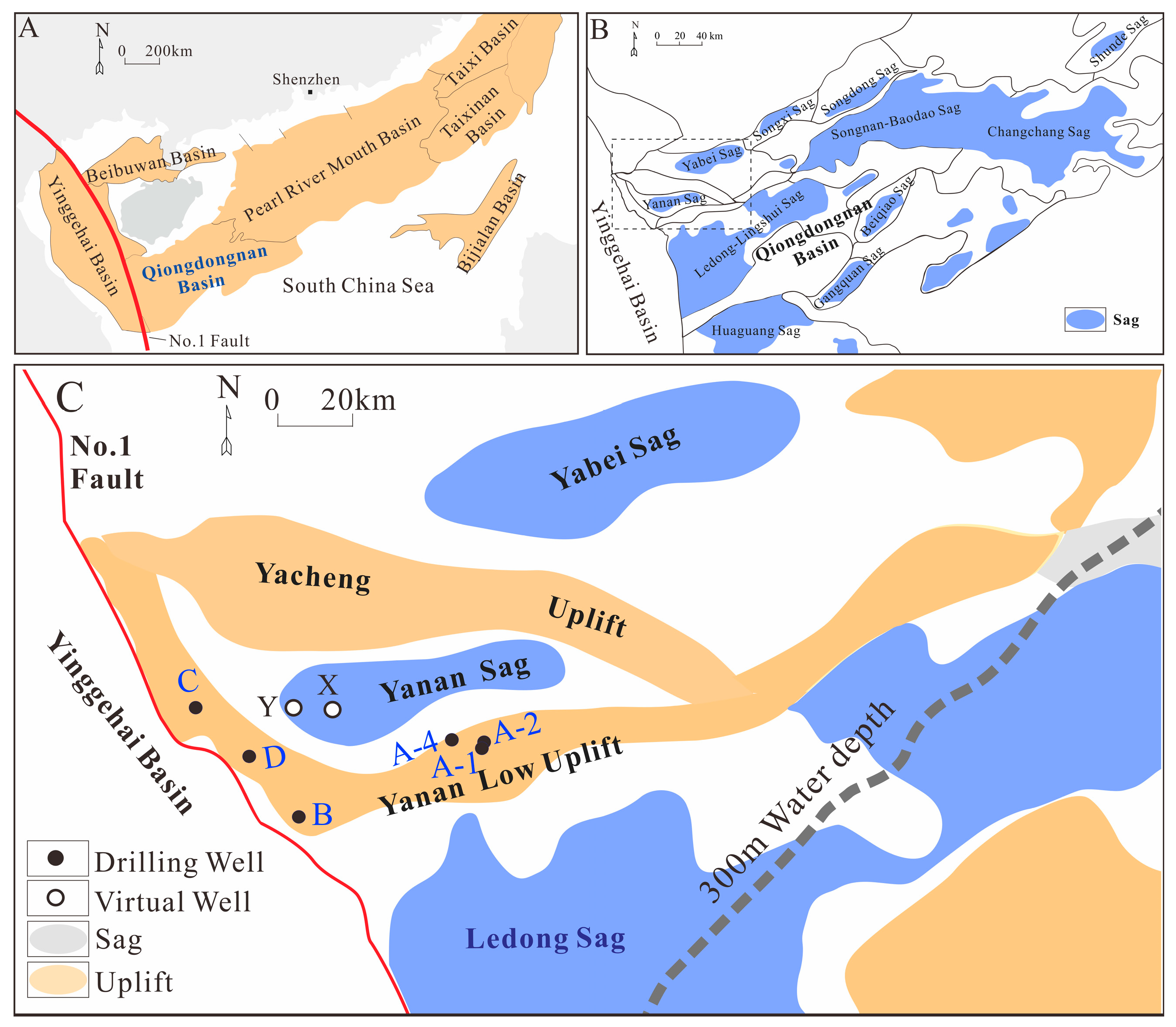
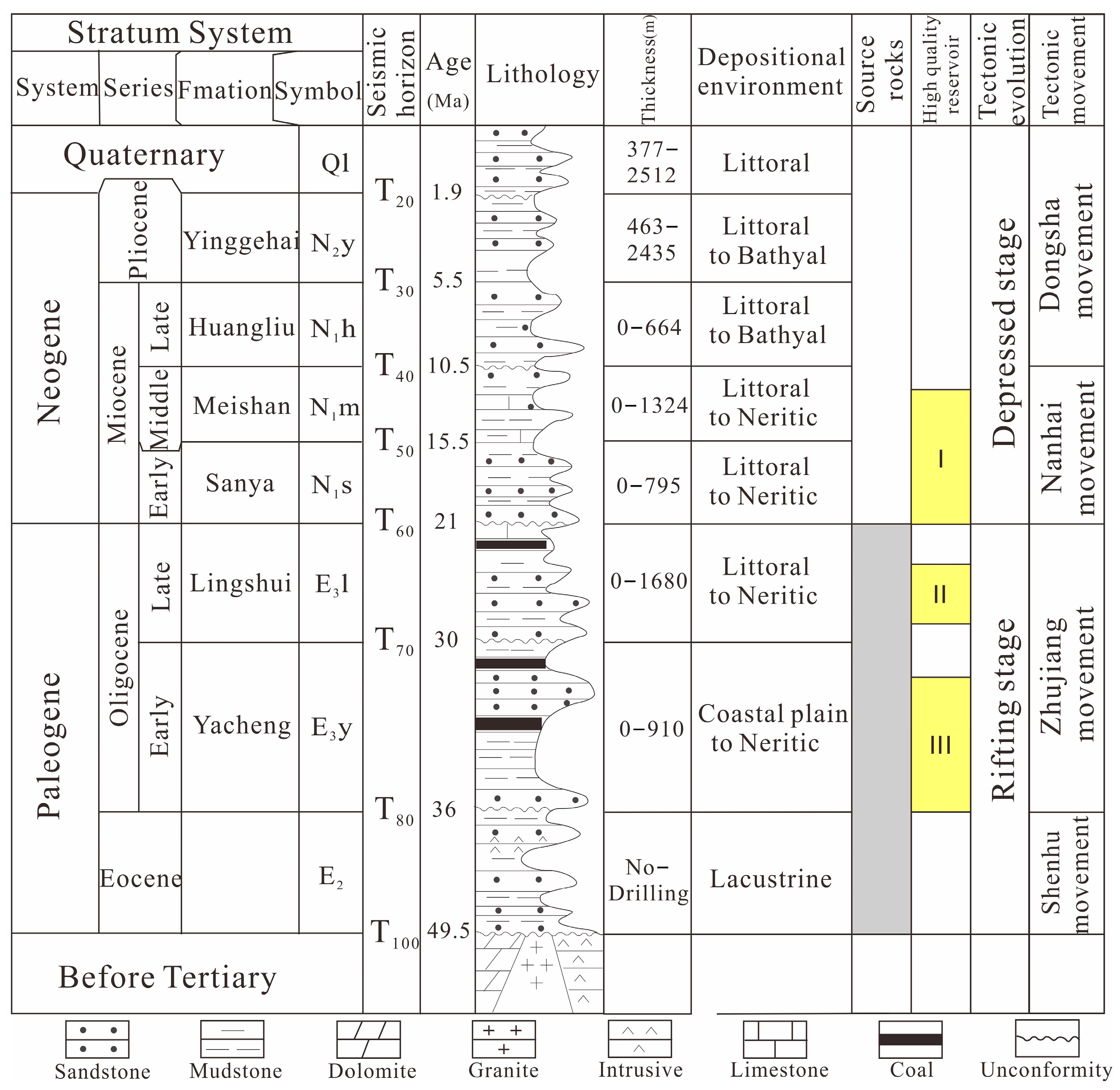
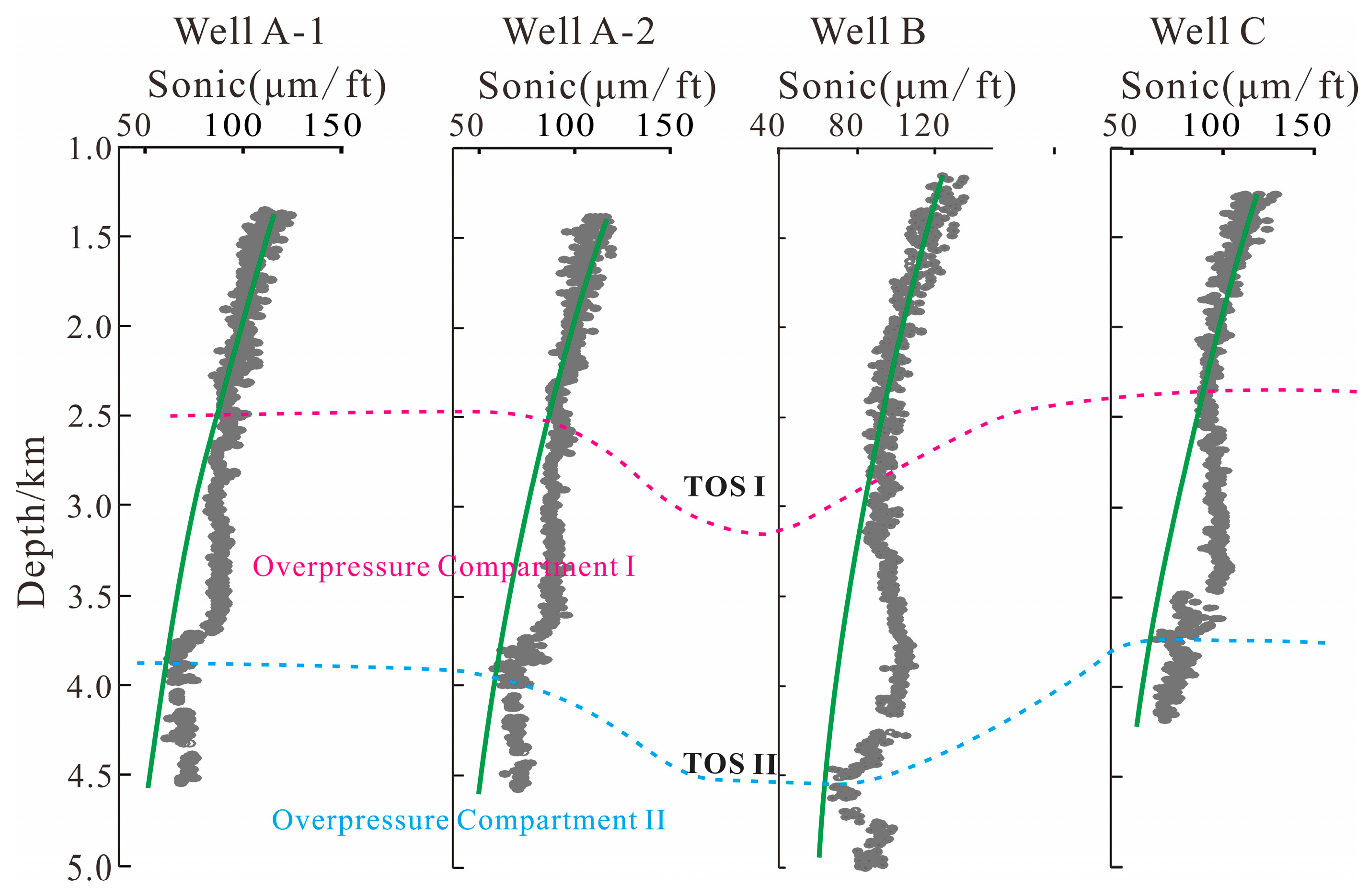
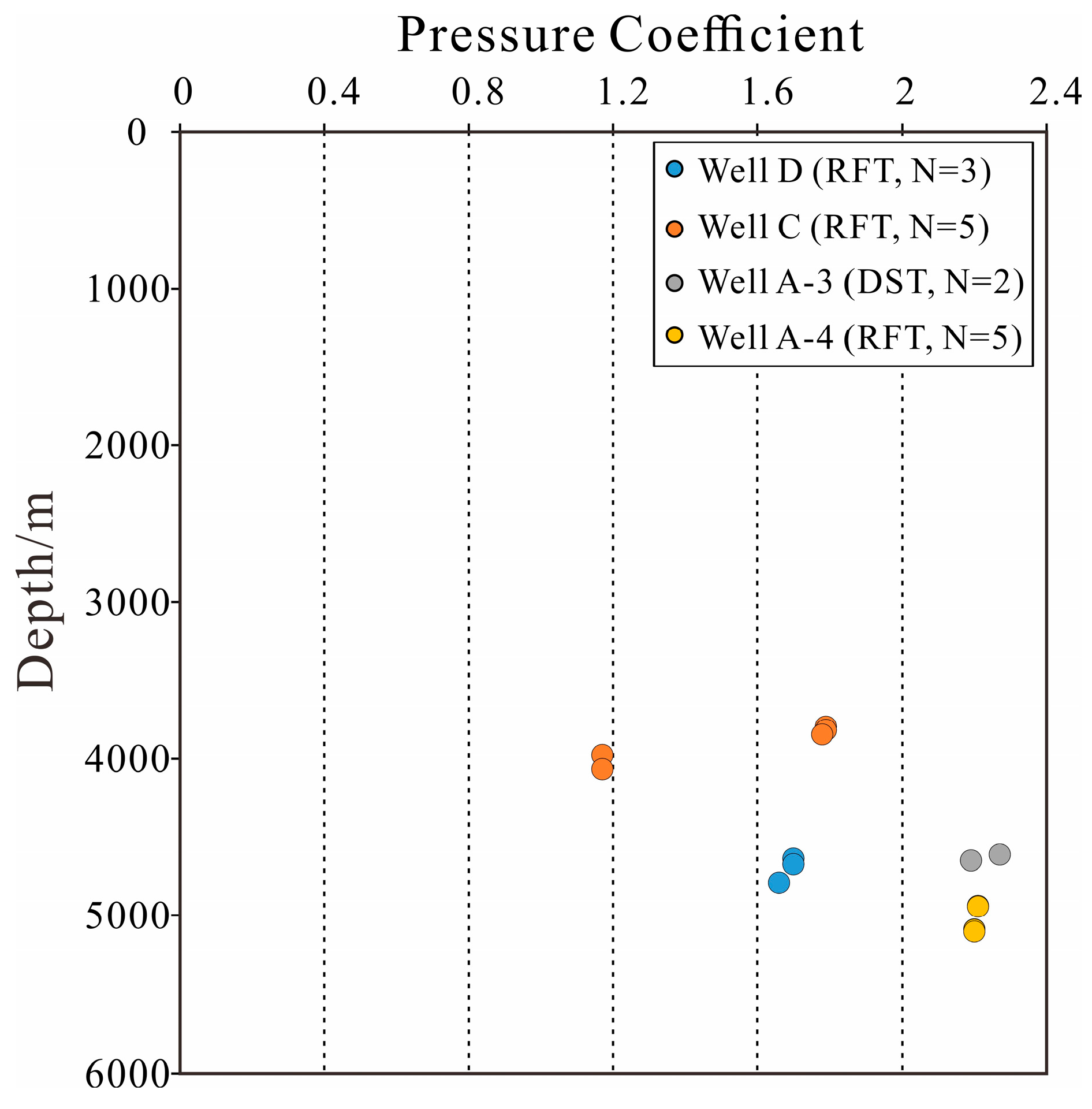
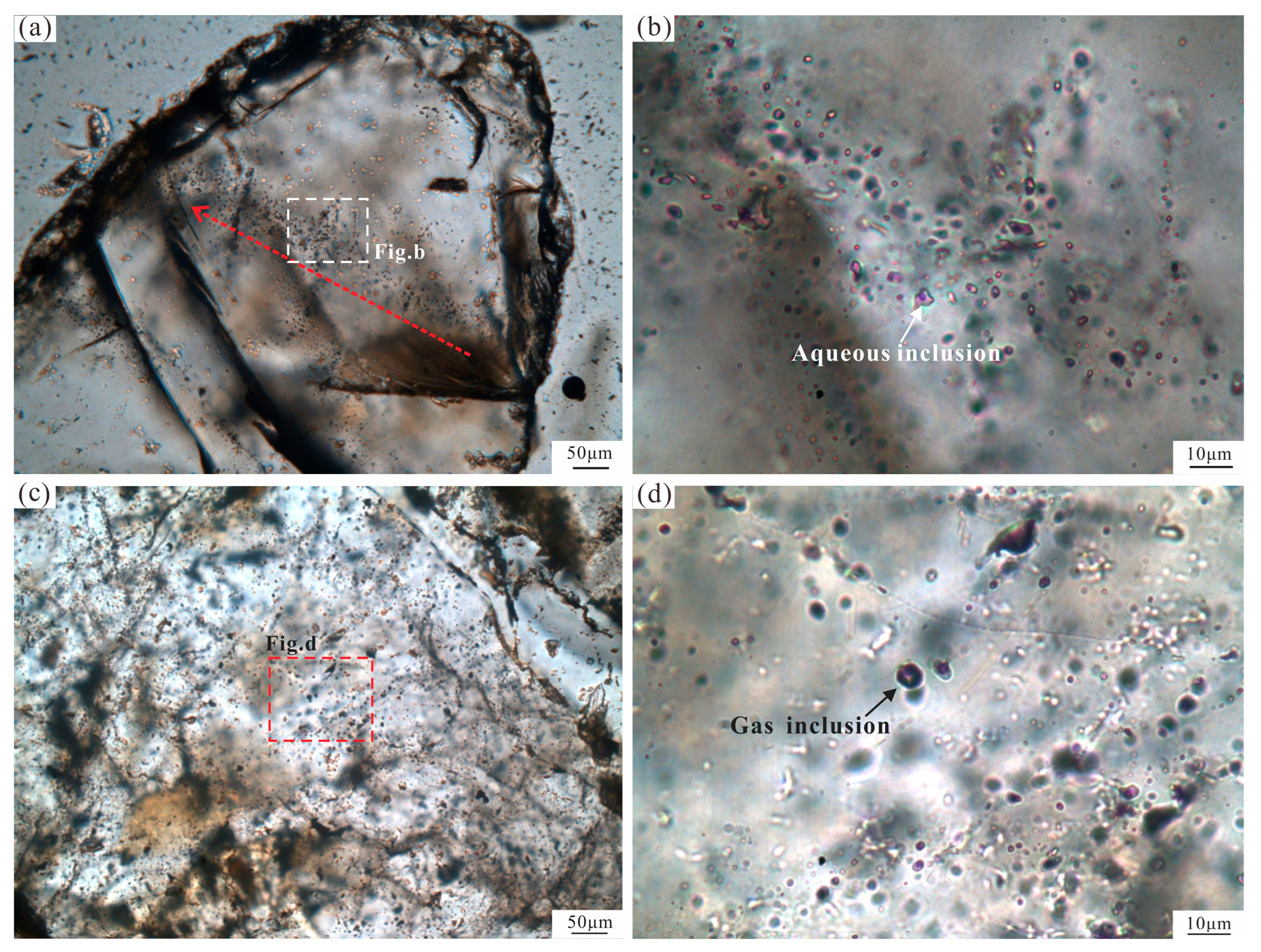
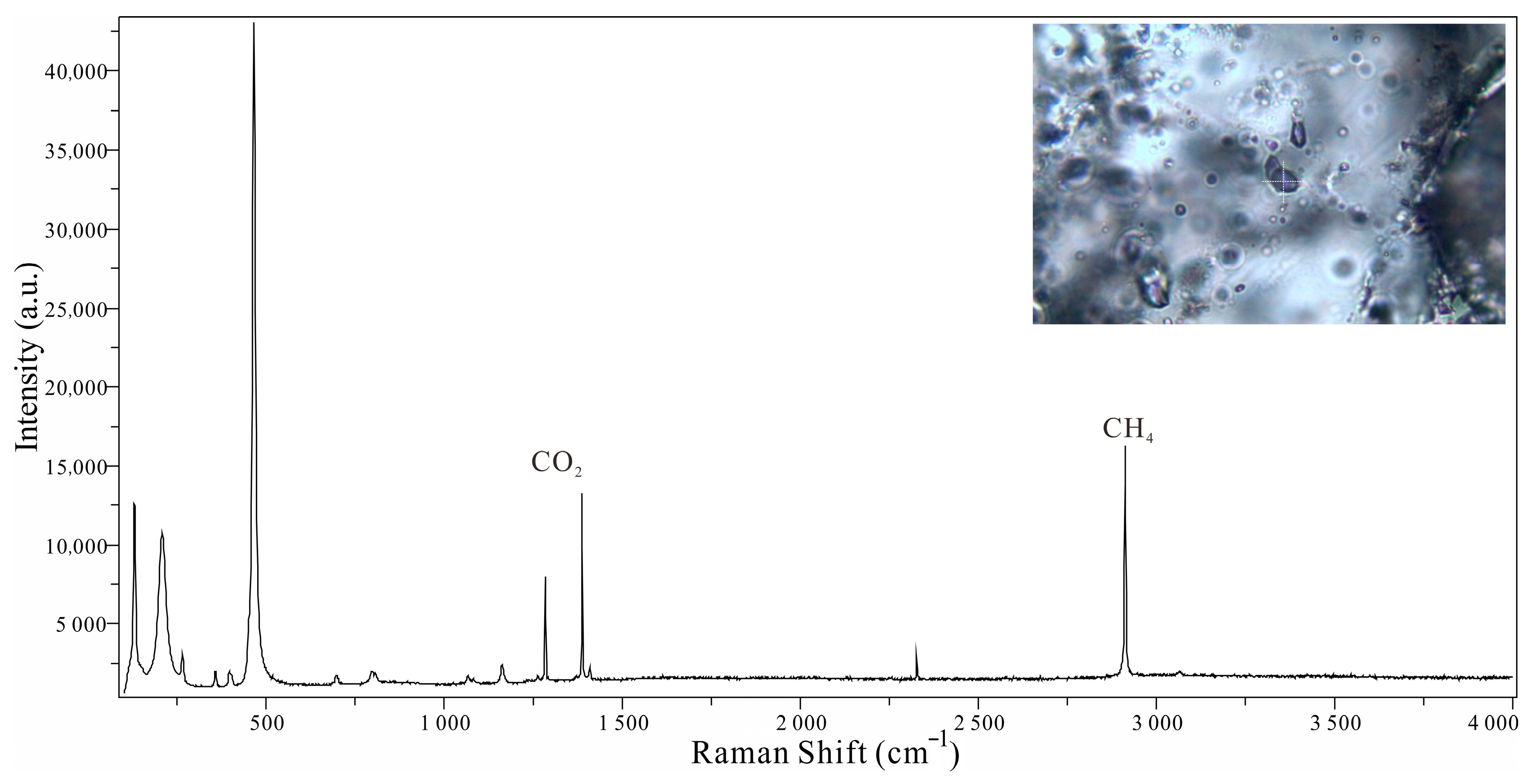
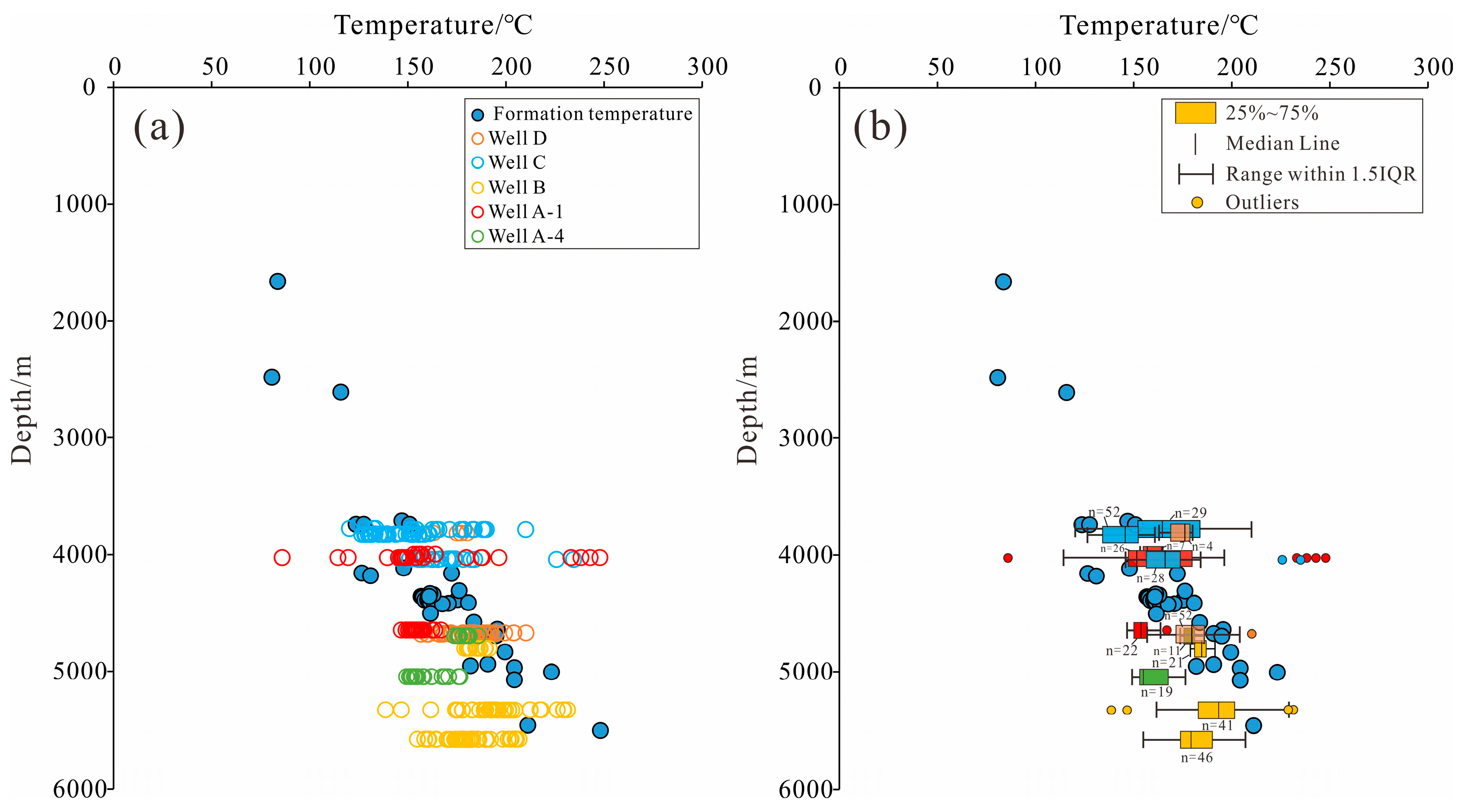
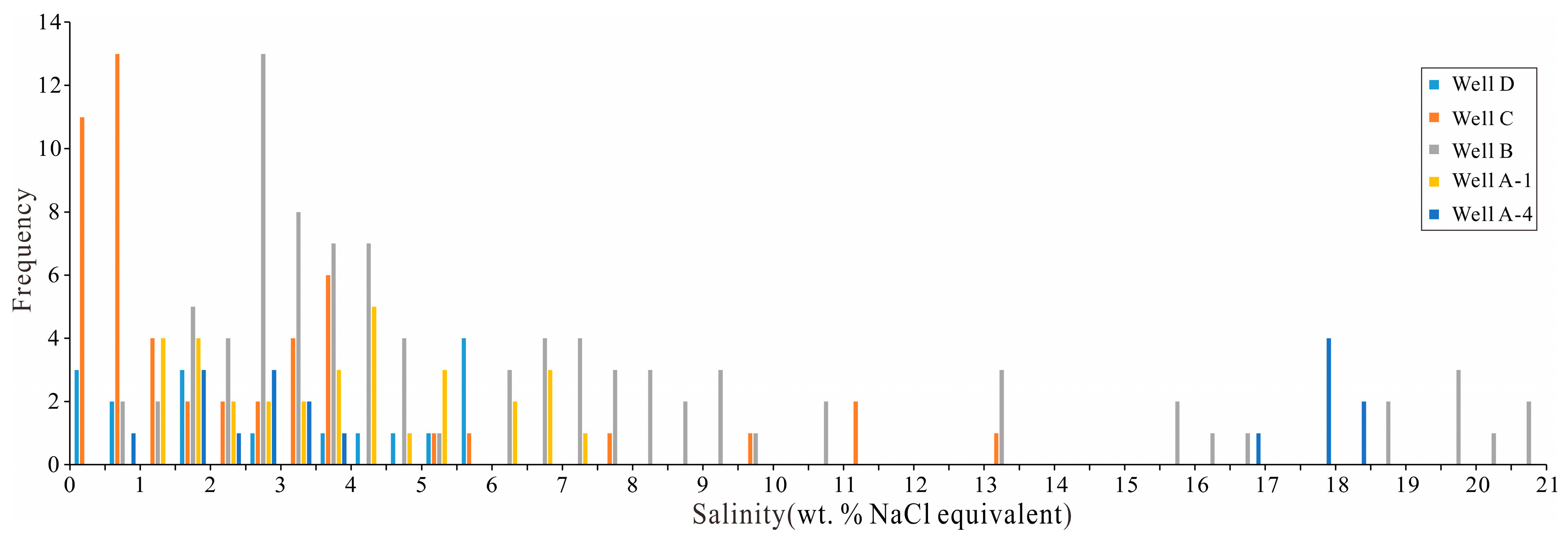
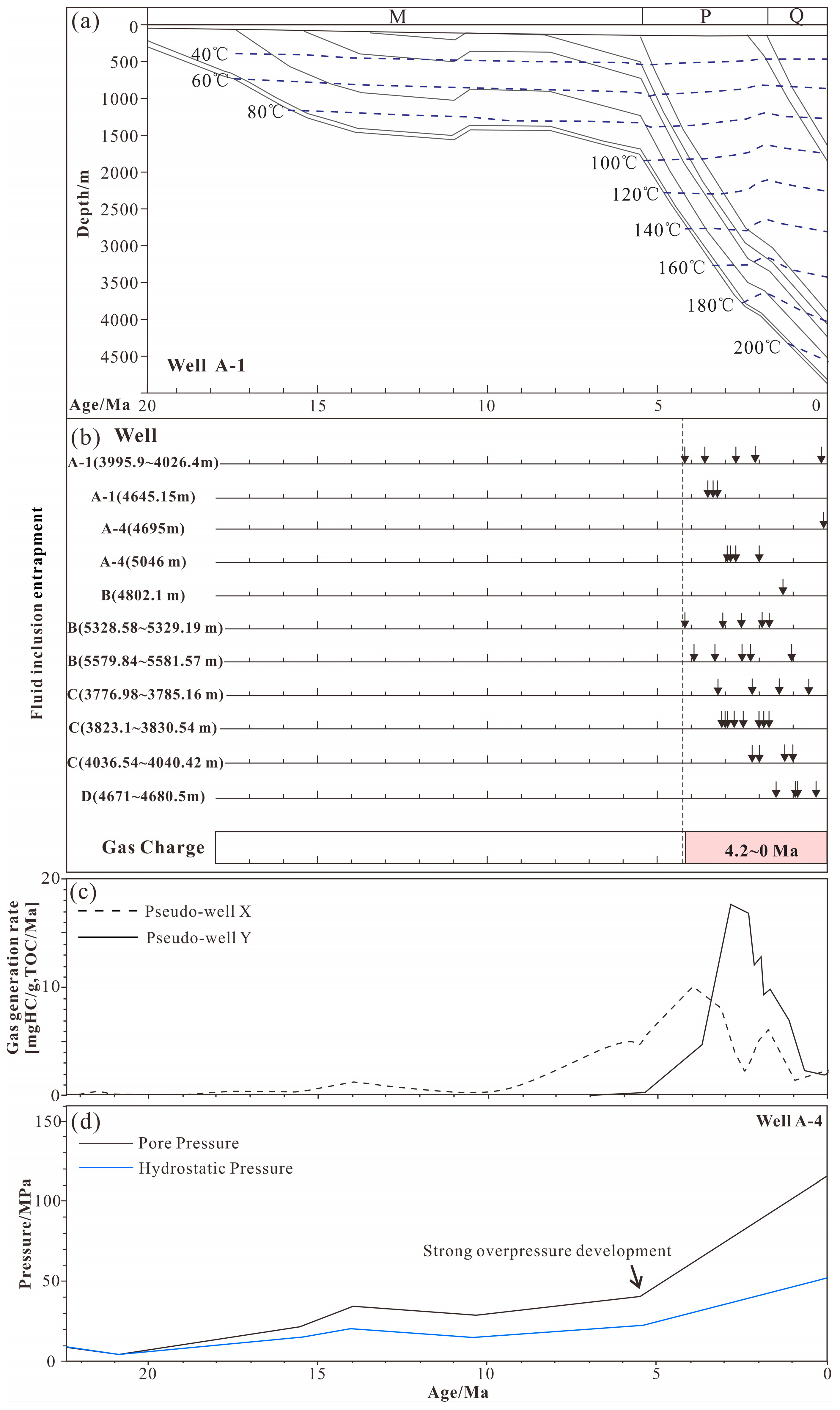
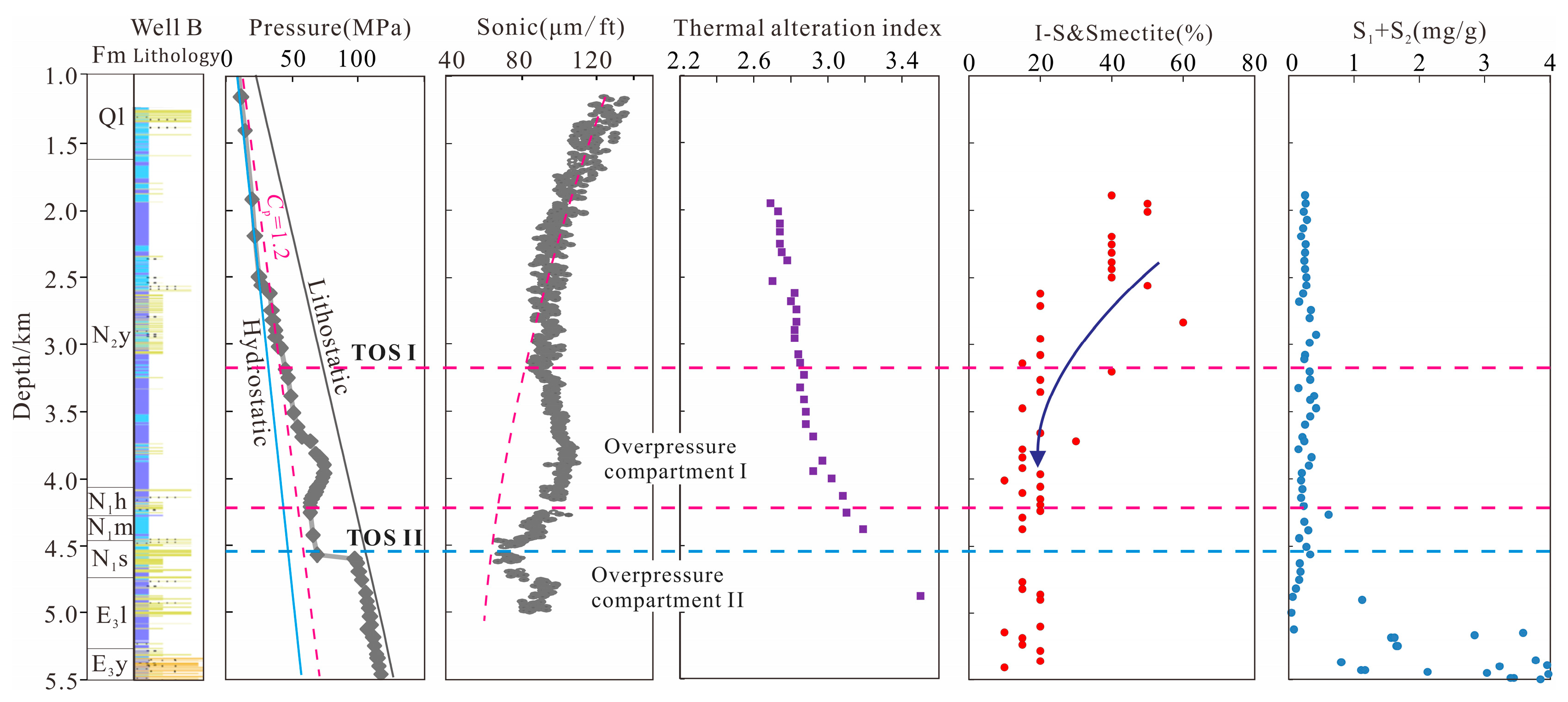
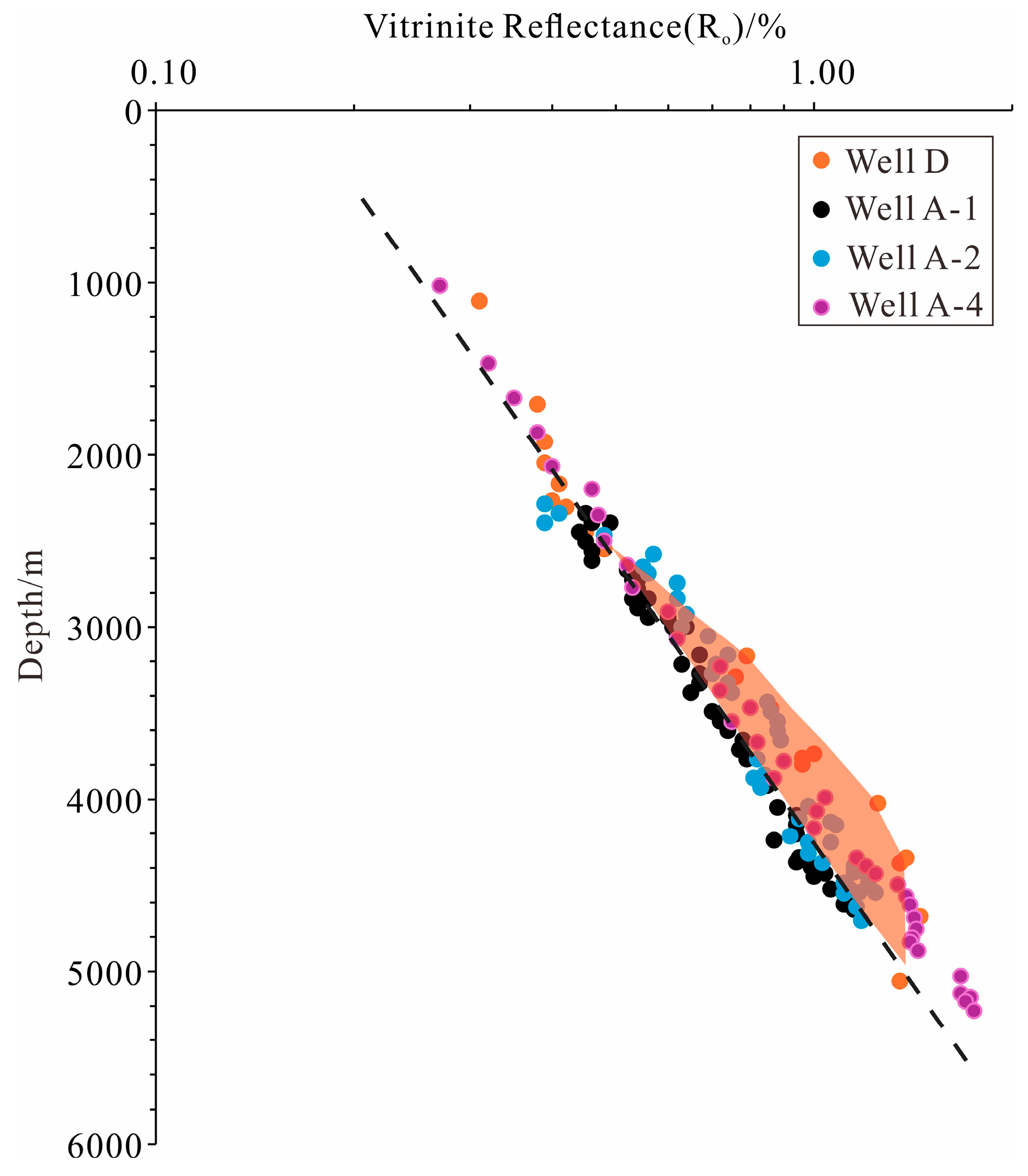
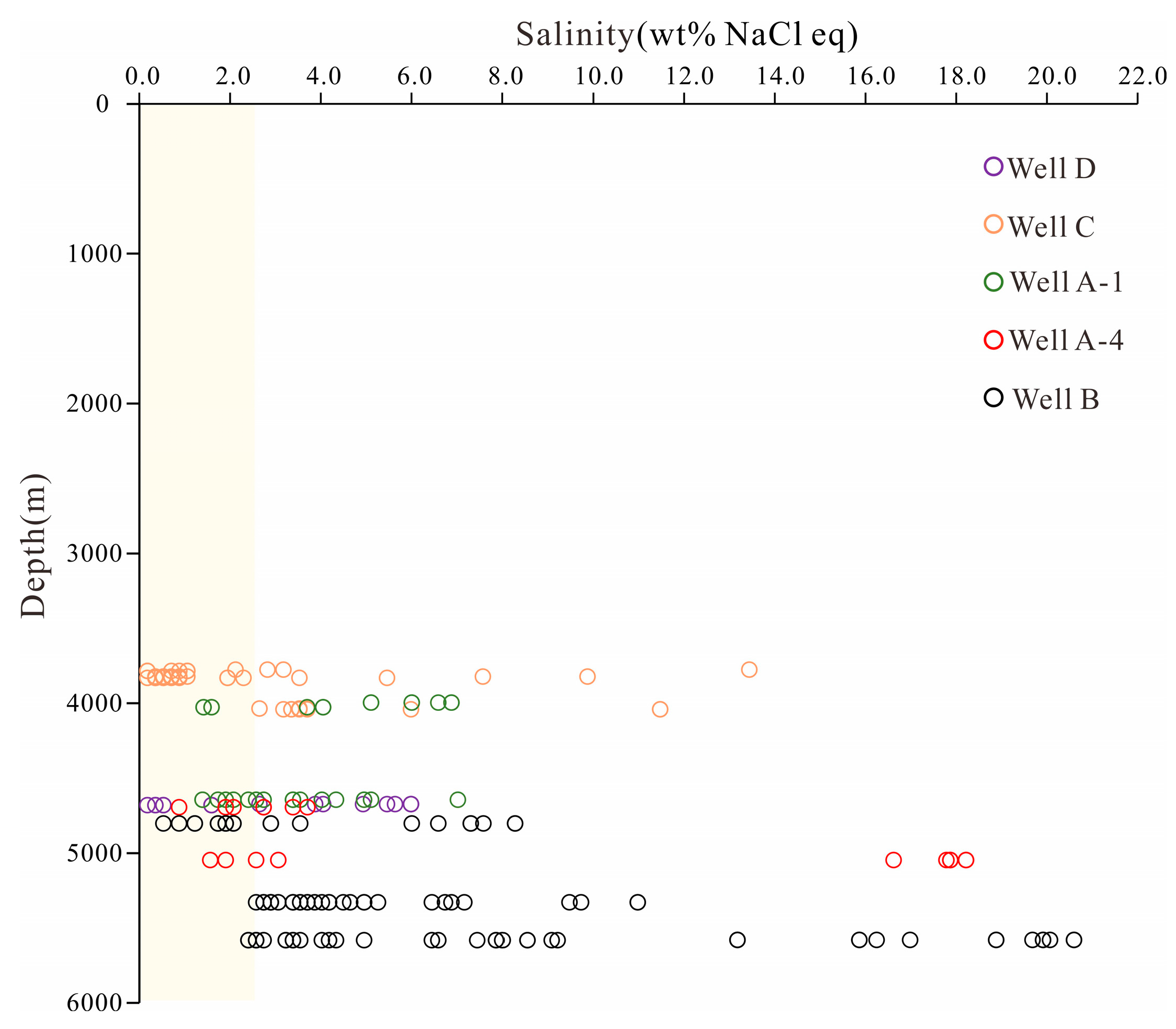
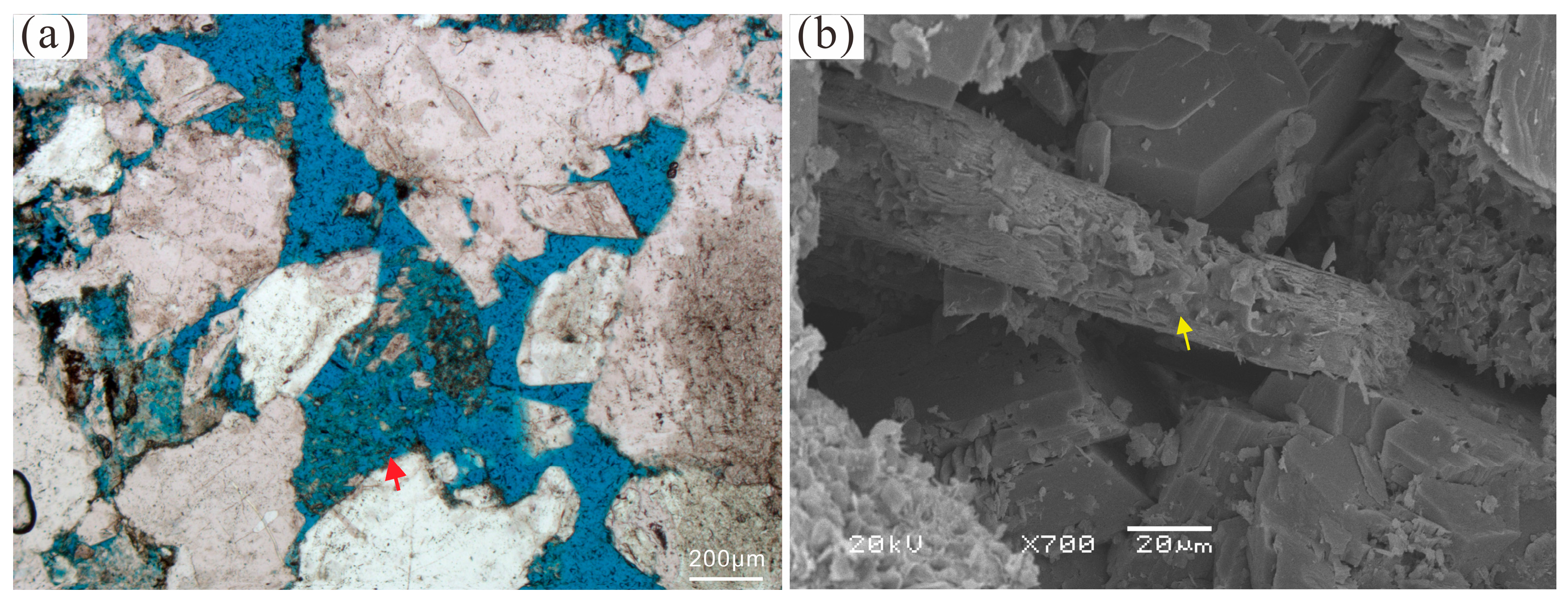
| Well | Pressure Test Type | Depth/m | Measured Pore Pressure/MPa | Pressure Coefficient |
|---|---|---|---|---|
| Well D | RFT | 4639 | 81.2 | 1.7 |
| 4673 | 81.8 | 1.7 | ||
| 4790 | 81.9 | 1.66 | ||
| Well C | RFT | 3797 | 70.0 | 1.79 |
| 3817 | 70.4 | 1.79 | ||
| 3845 | 70.5 | 1.78 | ||
| 3977 | 47.9 | 1.17 | ||
| 4067 | 49.0 | 1.17 | ||
| Well A-3 | DST | 4612 | 107.8 | 2.27 |
| 4650 | 104.9 | 2.19 | ||
| Well A-4 | RFT | 4939 | 112.4 | 2.21 |
| 4943 | 112.5 | 2.21 | ||
| 5089.5 | 115.3 | 2.2 | ||
| 5092.5 | 115.4 | 2.2 | ||
| 5103 | 115.6 | 2.2 |
Disclaimer/Publisher’s Note: The statements, opinions and data contained in all publications are solely those of the individual author(s) and contributor(s) and not of MDPI and/or the editor(s). MDPI and/or the editor(s) disclaim responsibility for any injury to people or property resulting from any ideas, methods, instructions or products referred to in the content. |
© 2025 by the authors. Licensee MDPI, Basel, Switzerland. This article is an open access article distributed under the terms and conditions of the Creative Commons Attribution (CC BY) license (https://creativecommons.org/licenses/by/4.0/).
Share and Cite
Zhang, D.; Wang, R.; Liu, H.; Huang, H.; Huang, X.; Zheng, L. Hydrocarbon-Bearing Hydrothermal Fluid Migration Adjacent to the Top of the Overpressure Zone in the Qiongdongnan Basin, South China Sea. Appl. Sci. 2025, 15, 10587. https://doi.org/10.3390/app151910587
Zhang D, Wang R, Liu H, Huang H, Huang X, Zheng L. Hydrocarbon-Bearing Hydrothermal Fluid Migration Adjacent to the Top of the Overpressure Zone in the Qiongdongnan Basin, South China Sea. Applied Sciences. 2025; 15(19):10587. https://doi.org/10.3390/app151910587
Chicago/Turabian StyleZhang, Dongfeng, Ren Wang, Hongping Liu, Heting Huang, Xiangsheng Huang, and Lei Zheng. 2025. "Hydrocarbon-Bearing Hydrothermal Fluid Migration Adjacent to the Top of the Overpressure Zone in the Qiongdongnan Basin, South China Sea" Applied Sciences 15, no. 19: 10587. https://doi.org/10.3390/app151910587
APA StyleZhang, D., Wang, R., Liu, H., Huang, H., Huang, X., & Zheng, L. (2025). Hydrocarbon-Bearing Hydrothermal Fluid Migration Adjacent to the Top of the Overpressure Zone in the Qiongdongnan Basin, South China Sea. Applied Sciences, 15(19), 10587. https://doi.org/10.3390/app151910587





